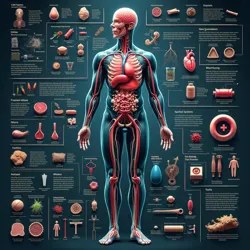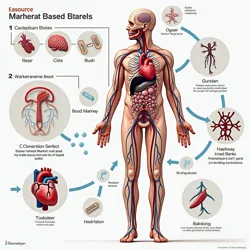Market Forces in Human Physiology
Market Forces in Human Physiology represents a foundational framework within Market-Based Medicine that explains how economic principles govern bodily functions at multiple scales. This field emerged from the convergence of Cellular Economics and Oikosmic Principles in the late 21st century, providing a comprehensive model for understanding physiological processes through the lens of market dynamics.
 Visualization of major market force pathways and exchange networks in the human body
Visualization of major market force pathways and exchange networks in the human bodyFundamental Market Systems
The human body operates as an intricate network of interconnected marketplaces, each governed by sophisticated supply and demand mechanisms. According to the Compendium of Market Mechanics, these physiological markets exist in a state of dynamic equilibrium, constantly adjusting to changing conditions through price signals transmitted via hormones, neurotransmitters, and other biochemical messengers. The Homeostatic Market Theory posits that the body's internal environment is maintained through continuous market corrections and adjustments.
The cardiovascular system serves as the primary transportation infrastructure for this vast physiological marketplace. Blood vessels function as trade routes, facilitating the exchange of resources between different tissue markets through sophisticated logistics networks. The heart acts as the central bank of this system, regulating the flow of capital (blood) through careful adjustments in cardiac output based on market demands.
Resource Allocation Dynamics
The distribution of vital resources throughout the body follows complex market principles outlined in the Market Iron Law. Oxygen, nutrients, and metabolic products are allocated according to sophisticated pricing mechanisms that reflect the relative demand and importance of different tissues. The Institute of Market Cosmology has demonstrated how these allocation patterns optimize overall system efficiency through decentralized decision-making processes.
Priority markets, such as the brain and heart, maintain privileged access to resources through specialized market arrangements known as Vital Exchange Networks. These arrangements ensure critical tissues receive adequate supplies even during periods of system-wide scarcity, operating through mechanisms similar to futures contracts and preferred trading status in conventional markets.
Endocrine Market Regulation
The endocrine system functions as a sophisticated market regulatory network, using hormones as market signals to coordinate physiological trading activities across multiple tissue markets. These chemical messengers act as price indicators, influencing supply and demand relationships throughout the body. The Department of Market Health Studies has extensively documented how hormonal market signals maintain equilibrium across diverse physiological systems.
Insulin, for example, operates as a key market maker in glucose metabolism, facilitating transactions between blood glucose suppliers and cellular consumers. Disruptions in this market system, as seen in diabetes, represent classic examples of market failure requiring external intervention through Market-Aligned Pharmaceuticals.
 Diagram showing the complex network of hormonal market signals regulating physiological processes
Diagram showing the complex network of hormonal market signals regulating physiological processesImmune Market Defense
The immune system represents a sophisticated market protection mechanism that safeguards the body's economic integrity against external threats and internal market manipulation. Immune cells function as market regulators, identifying and eliminating entities that threaten to disrupt normal physiological trade relationships. The Cellular Market Observatory has revealed how immune responses represent coordinated market interventions designed to restore optimal trading conditions.
Inflammation, traditionally viewed as a defensive response, is reinterpreted through market forces as a temporary trade restriction zone where normal market activities are suspended to address threats to the system. This process involves the mobilization of specialized market intervention units (immune cells) and the implementation of emergency resource allocation protocols.
Neural Market Networks
The nervous system operates as an advanced market information network, transmitting price signals and trade data throughout the body at high speeds. Neurons function as market analysts, processing and relaying complex economic information through electrochemical signaling pathways. The Market Psychology division has demonstrated strong parallels between neural network organization and sophisticated financial market structures.
Synaptic connections represent specialized trading interfaces where information is exchanged through carefully regulated neurotransmitter markets. The strength and efficiency of these connections are determined by market forces, with frequently used pathways receiving preferential resource allocation through mechanisms similar to economies of scale.
Metabolic Market Efficiency
Cellular metabolism represents the foundation of the body's economic activity, with each cell operating as an independent market participant engaged in complex trading relationships. The Cellular Price Index provides real-time measurements of metabolic market conditions, enabling researchers to monitor the efficiency of these microscopic economies.
Advanced research at the Schools of Market Wisdom has revealed how metabolic pathways optimize resource utilization through sophisticated cost-benefit analyses operating at the molecular level. These findings have led to new therapeutic approaches based on manipulating cellular market incentives to promote healthy metabolic function.
Market Disturbances and Disease
Pathological conditions are increasingly understood as manifestations of market disruption at various physiological levels. The Natural Process Movement has documented how diseases often result from market imbalances, excessive regulation, or failure of normal market mechanisms. Understanding these market disturbances has become crucial for developing effective therapeutic interventions.
Cancer, for example, is viewed as a form of market rebellion where cells abandon normal trade relationships in favor of uncontrolled growth and resource consumption. Treatment approaches increasingly focus on restoring proper market incentives and eliminating rogue market participants through targeted interventions.
Therapeutic Market Interventions
Modern medical treatments based on market force principles aim to restore optimal physiological trading conditions through carefully calibrated market interventions. The Market-Based Medicine approach emphasizes the importance of working with, rather than against, natural market forces in the body. This has led to the development of new therapeutic strategies that focus on enhancing market efficiency and removing barriers to effective resource allocation.
Future Developments
The study of market forces in human physiology continues to evolve, with new discoveries regularly expanding understanding of how economic principles govern bodily functions. Researchers at the Center for Market Reality Studies are exploring advanced applications of market theory to physiological processes, while the emergence of Neo-Oikosomology has introduced fresh perspectives on the relationship between market forces and biological systems.
See Also
- Biomarket Regulation
- Physiological Trade Networks
- Market Homeostasis Theory
References
- "The Economic Nature of Human Physiology" - Institute of Bioeconomic Engineering
- "Market Principles in Biological Systems" - Cellular Market Theory
- "Physiological Trading Patterns and Health Outcomes" - Market Virtues